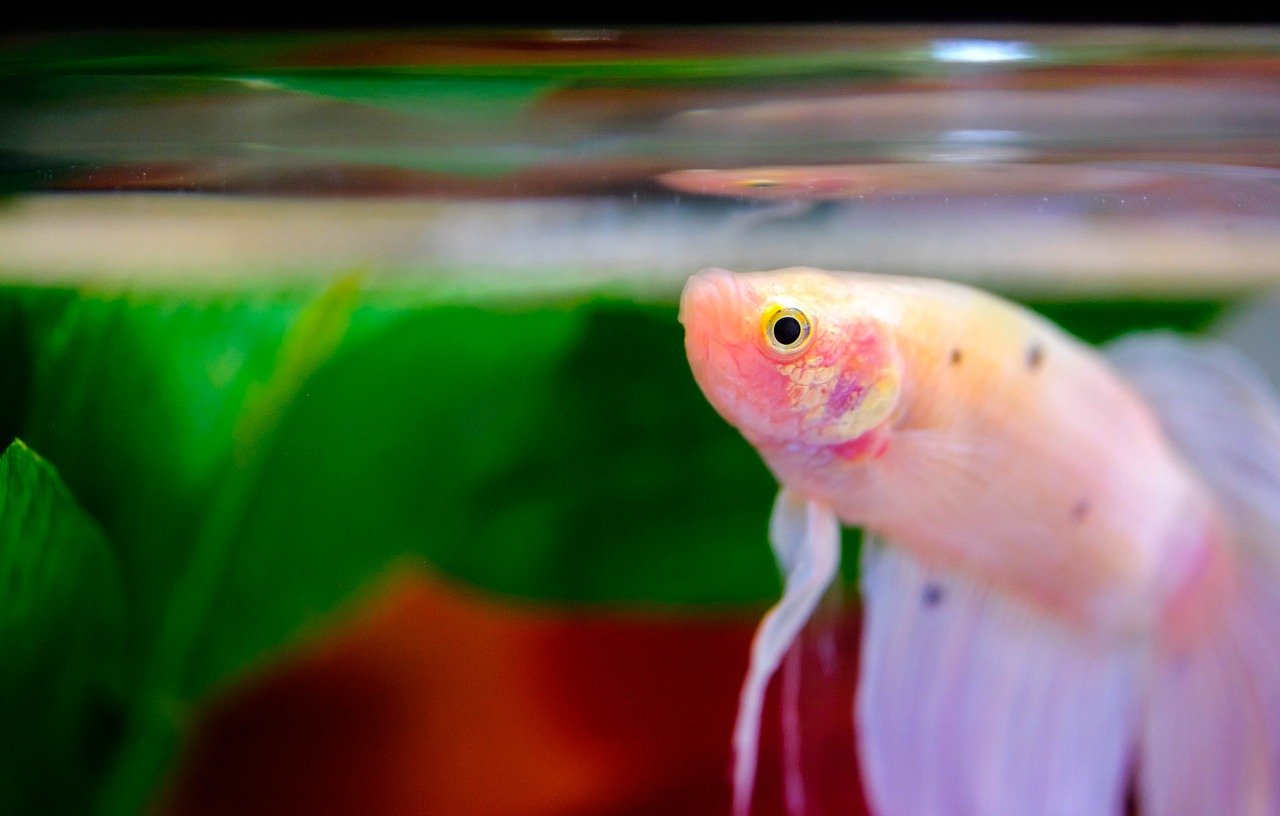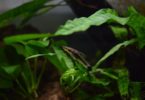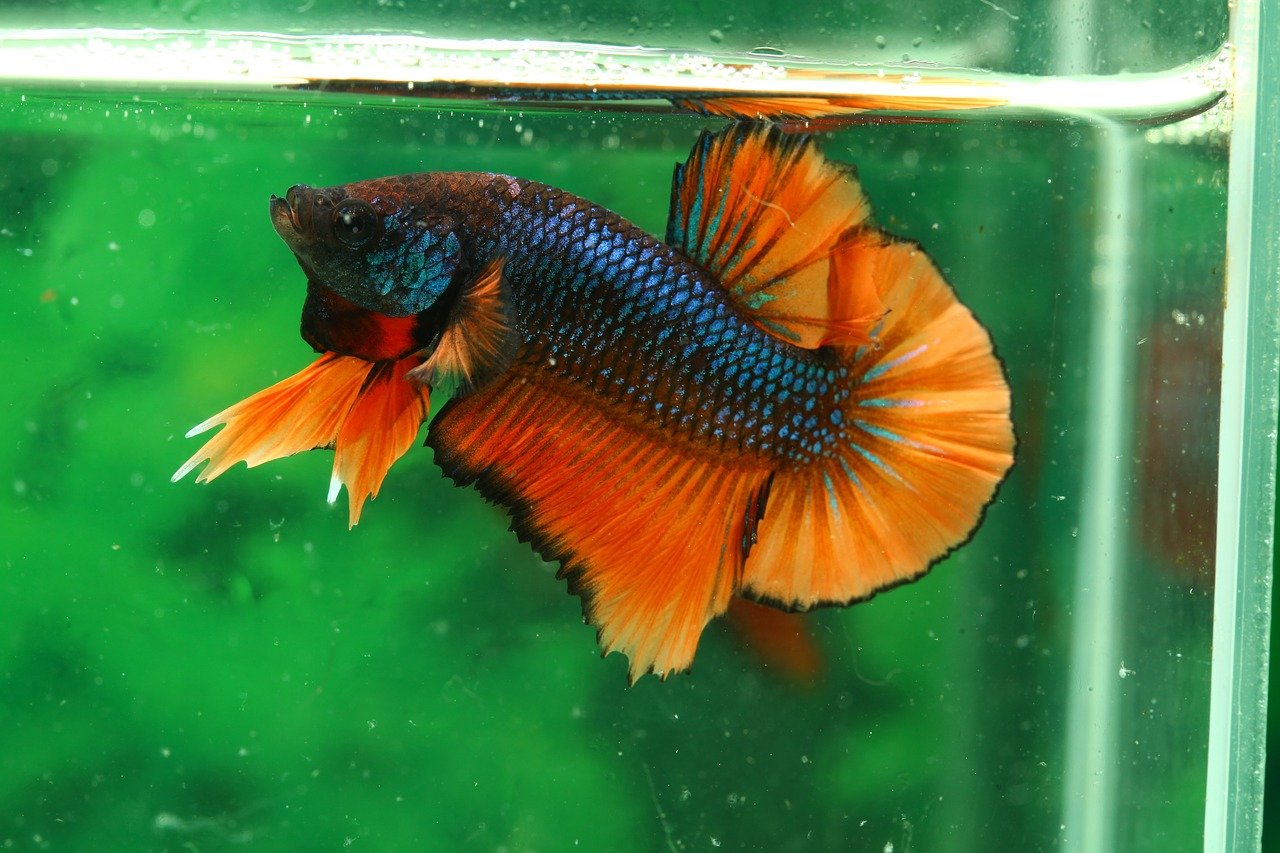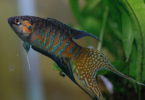Last Updated on February 10, 2023 by Matt
Betta fish are characterful fish that are very common across the aquatic trade, their unique behaviors and impressive tail fins attract so many people towards their species. One behavior of the betta fish that so many love is their sleeping pattern. Once in a while they rest their bodies on any curved surface they can find, and have a little snooze. Watching betta fish sleep is fascinating! After years of this unusual behavior many companies began making hammocks suitable for this fish to rest on, which obviously attracted the attention of many betta owners.
Now what actually is a betta hammock?
Betta hammocks are not the usual hammock shape that a person would sleep on hung in between trees, instead they consist of a small leaf shaped structure attached to a simple suction cup that is put onto the glass of an aquarium. Non invasive, natural looking and not to mention completely affordable, betta hammocks are the perfect addition to a betta fish tank!
IN THIS ARTICLE
Betta Hammock Benefits

Betta hammocks are beneficial for a betta in so many ways, here are just a few examples:
Sleeping:
As we know, betta fish love to sleep on leaves and other curved surfaces, so betta hammocks provide a safe space for them to lay on and have a rest. They also give bettas a dedicated spot for sleeping, as using any live plants in their aquarium could damage the leaves over time. Even though bettas like to have a nap in some strange spots around their tank, betta hammocks will help to give them a comfortable space to sleep, this will also reassure you that your betta is just sleeping and is not unwell.
Access to oxygen:
Betta fish have a labyrinth organ, meaning that they have the ability to take oxygen in from the air into its gills, so betta fish are able to take a breath from the surface. You might notice your betta swimming up to the surface of the water and start gulping the air, if other fish who don’t have this organ started doing this, it would be abnormal behavior and an indication of illness, but with bettas it is completely normal.
Having a betta hammock near the surface allows easy access for your betta to stay at the surface and not not have to strain themselves trying to stay in one position; bettas have long impressive fins that sometimes make it difficult to swim up to the surface and stay there. Having appropriate Betta fish plants can also aid in this.
Fills space:
Most planted fish tanks are filled with all kinds of sized plants, with some growing up to the surface and others being bottom growers. However, these plants obviously grow from the bottom up, that results in some empty space at the sides of the tank, particularly near the top. As betta fish need access to the surface, most floating aquarium plants are not suitable, leaving an empty space at the top of the tank.
Betta hammocks stick out slightly and can fill up that awkward space, making the aquarium look full with life.
Easily moveable and maintained:
Betta hammocks are not permanent and are held up by a suction cup, so when it comes to cleaning or you wish to move the hammock to a different location, simply pop off the suction cup and you are free to move it. They are also super easy to clean if any algae starts to build up on the leaf, just wipe it down with a sponge.
Why Is My Betta Not Using Its Hammock?
Most betta owners have success with their betta hammocks, and their bettas can be found spending hours having a nap on their leaf. Bettas seem to be naturally drawn to the hammocks, so it will likely be used if you install one. However, some are not interested in their hammocks, so if you have this problem, here’s some reasons why your betta might not be using its hammock:
1. It’s in the wrong place
Bettas will use their hammock if it’s in a calm and quiet spot, do not put the hammock where the strong current flows from the filter, this will cause them to be pushed off the leaf and it is not an area of the aquarium that they will want to rest in.
It may take moving the hammock to a few different places to find the spot the works best for your betta, these hammocks are usually put near the top of the tank, but your betta may feel too exposed if they are in the open, as they still have instincts to not rest in open spaces due to predators. If your betta is not interested in the hammock you may want to move it near some plants or a shaded area to make your betta feel more comfortable.
2. You leave the lights on for too long
Bettas do occasionally nap in the day, but they will have a longer sleep in the night when the lights are off. If you don’t turn the aquarium lights off at night, your betta may be getting confused and therefore can’t rest. Aquarium lights should be on in the day for around 10-12 hours, and off for the rest of the night, this can easily be one automatically with a timer attached to the light source, simply set the timer to the time you want the lights to turn off.
3. Your betta doesn’t see the appeal
If you have followed the above points, and your betta is just not interested, it can take some patience and persuasion. Putting a few pellets of food onto the leaf can help entice your betta to go onto the leaf. Hopefully, this will show your betta what a comfortable spot the hammock is.
Is a Betta Hammock expensive?
Betta hammocks are extremely affordable, from $3-$6 depending on the size and color. They are a great alternative to plants and other objects around the aquarium that you might not want your betta sleeping on. For the cheap price and beneficial outcomes, they are purchasing.
Can betta hammocks cause injury?
If used correctly, betta hammocks will not deliberately cause injury. To make sure they stay safe for your betta, ensure you clean the leaf when you clean the rest of the tank, use a sponge or old toothbrush to remove algae or food build up on the leaf. Whilst cleaning the leaf, always have a quick inspection to make sure there are no hazardous pieces sticking out or starting to deteriorate. As these are usually plastic structures, most have a thick piece of plastic or wiring piece inside to keep the shape of the leaf. Over a long period of time if the leaf starts to deteriorate, this piece of plastic or wiring might start to poke out, so running your finger over the leaf to check for any sharp edges will prevent your betta from getting hurt or their fins getting ripped.
Betta Hammock Placement

Where to put your betta hammock
The best place to put a betta hammock is near the top on the side of the tank, this will give your betta access to oxygen and gives them a new area of the tank to sleep in. Here are some other places to put your betta hammock:
Near the bottom: Some bettas might not be interested in the leaf hammock if it is too high up and exposed, so placing it near the bottom where it is closer to the other ornaments that are in the aquarium may make your betta feel more covered up.
In between foliage: As stated before, your betta might feel too exposed sleeping in the open, especially if the aquarium lights are bright. Having some plants near the side of the tank, and putting the leaf hammock on the glass in between these plants is a great way for your betta to feel safe and secure whilst sleeping, as this is what they would naturally do in the wild. In the wild, a betta would not sleep in the middle of the open water, as they would be exposing themselves to many predators.
Where not to put your betta hammock
Bettas can be fussy with where they want to sleep, so putting their leaf hammock in the right spot is important if you want your betta to make use of it. There are several places in an aquarium where it is best to avoid putting one of these hammocks in:
Near the filter outlet: As we stated earlier, it is best not to put a betta hammock near the filter outlet, especially if the current is strong. This is not an appealing sleeping area for a fish, encouraging your betta to stay in strong flowing currents like this can ruin their fins overtime and damage their small bodies. This strong flow may also cause more erosion on the leaf, meaning that you have to replace it more often.
On the substrate: Putting the hammock on the substrate will encourage your betta to spend most of its time on the bottom of the tank, and this may prevent them from wanting to use the space they have over time.
On the surface of the water: Even though putting them near the surface is the best place for them, make sure you do not put them too far up, as overtime the water levels will come down slightly and the leaf will then be out of the water and out of reach from your betta.
What can I use instead of a betta hammock?
Bettas hammocks are perfect for your betta to have a snooze throughout the day and night, however they might not suit your aquarium, or maybe your betta just isn’t interested and you need an alternative. There are a few ways to give your betta a natural sleeping spot, one being tall plants with wide leaves. Anubias plants are great for this, they can grow pretty big and have wide, cupped leaves perfect for a betta to curl up in. Live plants are the best option for a sleeping area, as they are soft and won’t harm your betta. Fake plants can be used as long as they are the silk kind, hard plastic plants are likely to tear your bettas fins.
Catappa leaves, also known as Indian Almond leaves, are well known across the aquatic community, and bettas love to use them as beds! They have many more benefits than just a sleeping area, these leaves have healing properties than many betta owners actually use as a natural medicine. They also help to condition the water and balance the water’s pH, they can also help to keep aquarium ammonia at a safe level; ammonia poisoning will occur even at very low concentrations. Therefore these leaves can really benefit the water conditions. If you use a few of these leaves, they can tint the water, however this can create a much more natural looking environment, and also benefit your betta as they shield them from the harsh aquarium lights.
Catappa leaves can be put into the water and they will sink or float depending on the leaf, the ones at the bottom are great for any bottom dwellers or shrimp that you may have in the tank, and the ones floating at the surface will create a comfy bed for any betta. To get your hands on these catappa leaves, see below:
Where can I buy a betta hammock?
Betta hammocks come in different colors and sizes, some are even adjustable to suit the size of your betta. Betta hammocks are being sold in various pet shops, however here are the ones we recommend:
Single leaf betta hammock
- A naturalistic leaf hammock for your betta to rest on
- Allows your betta to rest near the surface of the water like they do in nature
- Attaches easily with suction cup (included)
- Made in the USA
This is a basic betta hammock that includes one leaf and one suction cup, it can be out anywhere in the aquarium and will go perfectly with any light green colored plants.
Check out a Betta fish using this hammock below!
5 pack double leaf betta hammock
This pack includes 5 separate betta hammocks that each have two leaves attached to one suction cup, creating a double bed for your betta! These will give your betta lots of choice of where to sleep around the aquarium as they can all be places at different heights, or even in the same place to create a bundle of leaves for your betta to hide amongst.
6 pack multiple leaf betta hammock
- Package contents: you will receive 6 pieces of betta leaf pads in 6 styles; Each leaf pad contains different sizes of leaves,...
- Quality material: the betta fish leaf pad is made of quality plastic, which is safe and non-toxic; You can use these realistic...
- Delicate design: there is a strong suction cup under the betta fish leaves, which can facilitate you to fix the leaf pad on the...
This pack comes with six separate betta hammocks, however these particular ones come with a bundle of leaves attached to one suction cup, this will create a fuller look in the aquarium and give your betta lots of options.











